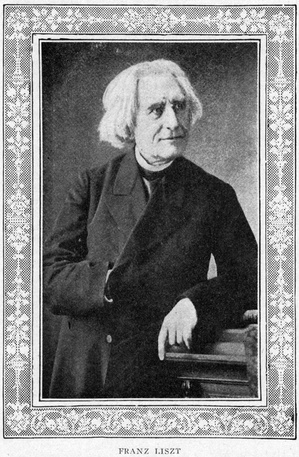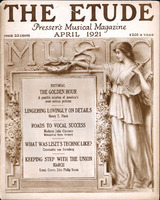This question has been asked of me by students, teachers and other music lovers, with such frequency as to induce me to attempt an analytical description of Liszt’s technic, although the task is one before which not “to falter would be sin.”
We usually mean by “technic” a well trained human playing apparatus, a well developed finger mechanism, supported by wrist or arm or both, as the case chances to require. We mean the “mechanical” side of music-making; that side which has nothing to do with spirituality except to serve its purposes as an unquestioning underling. This technic can be acquired by any one that has a good drill master and the requisite persistence in practicing, because it is “mechanical.”
If in the face of this definition of technic I should speak of such a thing as a “spiritual technic” I should run the risk of being laughed at, and yet—there is such a thing, as we shall presently see in a crude exemplification.
Among the people that apply to a teacher for lessons there is occasionally one who makes the teacher wonder how he can play as well as he does with entirely untrained hands. He cannot and does not play well, of course; he spoils everything that demands digital skill, but succeeds nevertheless in delivering at least the rhythm, the melodic passages, the general outline, in short, a sort of shirt-sleeve, rough and tumble sketch of the piece which can be understood, though of course not played. Every teacher has probably come across such an applicant and readily diagnosed his case as “the head too far ahead of the fingers.” But by this very diagnosis he admitted that the applicant did possess a musical head and one that was strong enough to compel the fingers to do its bidding, somehow, in some way, be it never so queerly, but at the same time well enough to make itself, at least, understood. This is the sort of technic which I mean by a crude “spiritual technic.”
Now let us assume the combination of two things; first, a musical mind that takes rank among the greatest in musical history and second, a pair of hands trained to perfection by Czerny, himself; in other words, a playing apparatus so highly developed as to enable the mind to do with it whatever it pleases; a set of fingers which are the obedient slaves of the player’s every whim or caprice and serve the musical mind without its being in the least conscious of the service. If we can stretch our imagination so far as to conceive of this combination we shall have caught a glimpse of that “spiritual technic” which Liszt had at his command. “Spiritual,” I must call it, because its base was not mechanism but—personality. (Just as it is not mechanism but personality which speaks in the playing of the aforesaid untrained applicant for lessons.) Let me call it a rudimentary mechanism transformed by personality.
Personality, then, being the base of Liszt’s technic, we must regard it a little closer to discern its attributes. His education was of the broadest possible, including the complete mastery of five languages (he could even “converse” in Latin). His erudition might have been envied by many a professional litterateur or scholar. His social polish, his natural noblesse, gentility and unvarying amiability no diplomat could excel and few could equal. (On account of its irrelevancy to the present discussion I omit, regretfully, his infinite kind-heartedness.) Were these the qualities that produced Liszt’s great personality? Why, no! That would be putting the cart before the horse. It was his God-given personality which urged him to acquire his multiform knowledge, to develop his social graces. It was because of what he had to say that he reached out for a broad education as for a means to express himself clearly and adequately. And it was the musical side of his personality which—endeavoring to put into tonal reality what was in his mind—caused him to use his technic with such results as amounted to the creation of, practically, a new technic.
To start with, he did not regard his playing apparatus as consisting of two parts of five fingers each, but as being one of ten fingers. This employment of the fingers regardless of “left” or “right” can be seen in the contrapuntal works of Bach and his contemporaries; but it fell soon into disuse and was not resumed until Liszt used it in his own style. He did not see why he could not put the “thumb just as well over the third, fourth or fifth finger as under it and illustrated this use in the four superswift scales in the “Rhapsodie Espagnole.” Octaves of great rapidity, embodying at the same time a thematic design, were not known before Liszt; not, at least, in the manner in which he uses them in the A minor Tarantella from La muette de Portici, an opera known in English as Masaniello (the name of its hero). Configurations of rapidly alternating half and full steps, as in “Feu follet,” are also of his daring invention. Employment of one hand alone, where the use of both hands was easier but would fail to produce the desired tonal effect, occurs, e. g., in his “Ricordanza.” Dividing the melody between the two hands in such a way that the supporting broad arpeggios may keep up their steady flow (D flat Etude)—to which the nearest approach was made (a good deal later) by Rubinstein in the “Melody in F” and by Mendelssohn in his E minor Prelude—was also one of Liszt’s innovations.
Liszt’s Intensely Musical Nature
The novelty of these and other things, too many for enumeration, becomes quite apparent when we compare Liszt’s playing apparatus (of ten fingers) with that of his three great contemporaries,—Chopin, Schumann and Mendelssohn, particularly the latter two. Moreover, these technical innovations are very distinctly the result of Liszt’s musical concepts. In other words, the pieces in which these innovations occur are not written round the technical matter, but the technical execution had to be invented to produce the desired effect of the pieces; and the invention of the technical means came of itself to him when he tried his ideas on the piano.
Now I know perfectly well that Liszt was a mortal of flesh and blood, that he had muscles, tendons, flexors and what not, like other people; but I also know that he was so intensely musical through and through that a tonal picture conceived by his mind transmitted itself—I dare say, unconsciously—to his hands; that his musical will was so strong and so definite in its concepts as to require for its mechanical enactment nothing more than that independence of each finger which he had acquired in his childhood.
When Liszt Went Off to Practice
Ordinary “practicing” could not help such a musical individuality; yet, there is a period known in Liszt’s life when he actually “practiced.” It was—I think, 1836—when Thalberg’s playing in Paris threatened to weaken the after effect of the powerful impression which Liszt had left there on the public. Bent upon conquering Thalberg, not for personal gratification but for the sake of music, of Bach, Beethoven and Schubert, Liszt went to Switzerland for six months to “practice.” It must not be thought, however, that he sat down to endless and slow repetitions of certain passages, like any other good boy. I was, of course, not present then, but the ordinary modes of practicing in conjunction with Liszt are unthinkable. His “practicing” consisted, I think, rather of experimenting with the piano to produce new, self- invented tonal effects such as had never been heard before, to make the piano say things of which it was hitherto regarded as incapable; in short, to bring to Paris a new musical instrument, so to speak.
Ordinary practice would have been of no avail to conquer Thalberg; because scales, arpeggios, etc., cannot be more than perfect, and to this perfection Thalberg had attained as well as Liszt. To conquer so formidable a rival (however unworthy of comparison), Liszt had to go deeper into music itself, into its action upon the soul and imagination. As for merely flattering the ear, Liszt could have done no more than had been done by Thalberg. When the latter played, the audiences were charmed; but, the concert finished, they went about their business as before. They had had a very refined “amusement” which, at best, was pleasantly remembered. Listening to Liszt, however, they went through soul stirring “experiences;” they had suffered, hoped, triumphed under the sway of the music that came from the conjurer at the piano.
It has been said that Liszt learned certain things from Thalberg. Even Duncan Hume, Thalberg’s biographer in Grove’s dictionary, inclines to believe it. But the admirers of Thalberg, who have set this tale afloat, overlooked two significant matters: Thalberg’s mission (if it deserves to be called a mission) consisted solely and exclusively of the display and exploitation of his beautiful touch, an important but none the less auxiliary matter. Liszt used his playing in the most unselfish manner, as a propagandist for Bach, Beethoven, Schubert, and for championing (also in composition) the Neo-German movement in music, a movement of which he was the head and in which Schumann, Wagner and Peter Cornelius were congenial followers.
A man moving on so high a plane of thought does not bother about a little technical matter, such as that which Thalberg’s friends (not Thalberg) have referred to. Supposing that Liszt had actually used some little detail in keyboard treatment which Thalberg had also used, it should not be overlooked that the improvements of the piano as an instrument—though they were the makers’ response to the growing demands of the pianists—had a stimulating effect upon the piano-composers, and may easily have suggested the same new effects to more than one musician. The idea of Liszt learning something from Thalbert (sic) is absurd. Jupiter learning from—Trinculo!
Liszt’s Educational Concerts
Liszt’s every concert had an educational purpose, not as a lesson in piano playing—indeed, not!—but as an elevation of the public’s musical taste. His mind was occupied with higher, worthier interests than those which moved Messrs. Thalberg, Herz, Prudent, Dőhler, Kalkbruenner & Co.
The reader will by this time have realized that an analysis of Liszt’s technic must be a thankless undertaking because of its futility. The charm of his playing—even in his late sixties when I listened to it and forgot all about the world of so-called realities—lay in his spirituality. To omit this element in the analysis would be like describing a composition by its ink and paper. Admitting the spirituality, however, his playing defied analysis; the technical side eluded critical observation; it completely escaped our notice by hiding itself within the broad esthetic totality. It was “art concealing art.” Anyone who has sat at Liszt’s feet—and there are still some of us alive and in this country—and hear a pianist’s technic spoken of with admiration, as is now so often the case, knows at once that that particular pianist is not an artist, however clever a keyboard acrobat he may be. Let people speak of the compositions, played by that pianist, or his conception of them, of his temperament, if they wish; of his versatility of style, or anything and everything but his technic unless—indeed—unless his higher musical qualities were not able to divert our attention from his technic. (Does anyone ever speak of Josef Hofmann’s technic?) To speak of technic when discussing Liszt’s (or, for that matter, Rubinstein’s) playing, is a profanation. They did not “play the piano”—they “made music” on the piano. They gave themselves, their very heart and soul to their audiences, while the technic was but the concomitant outflow of a towering and marvelously intense
PERSONALITY.




